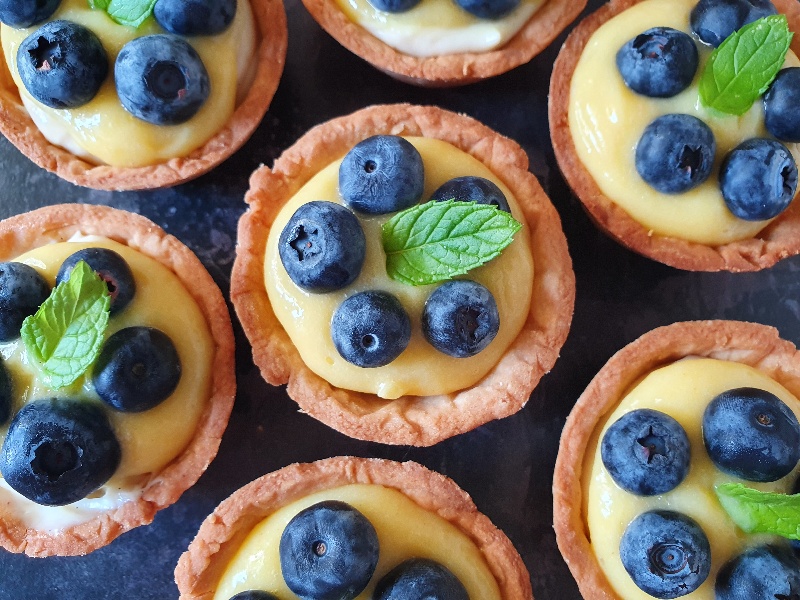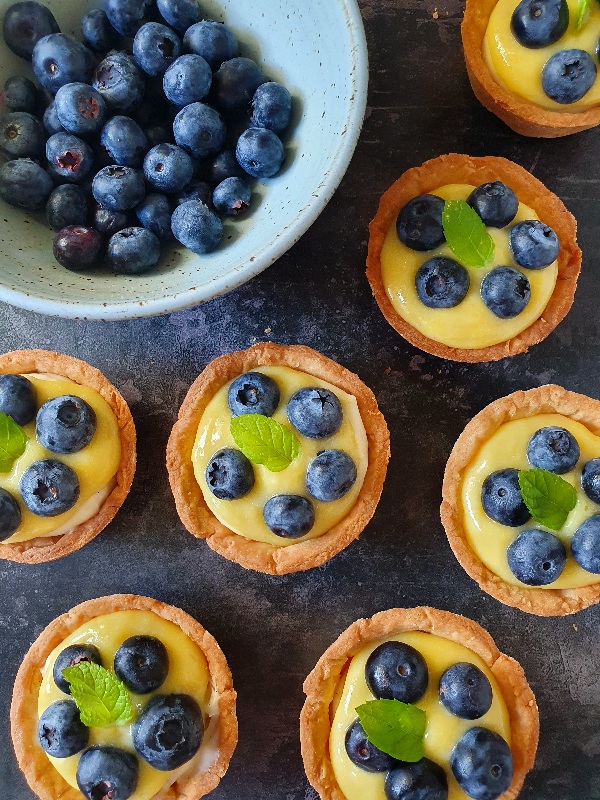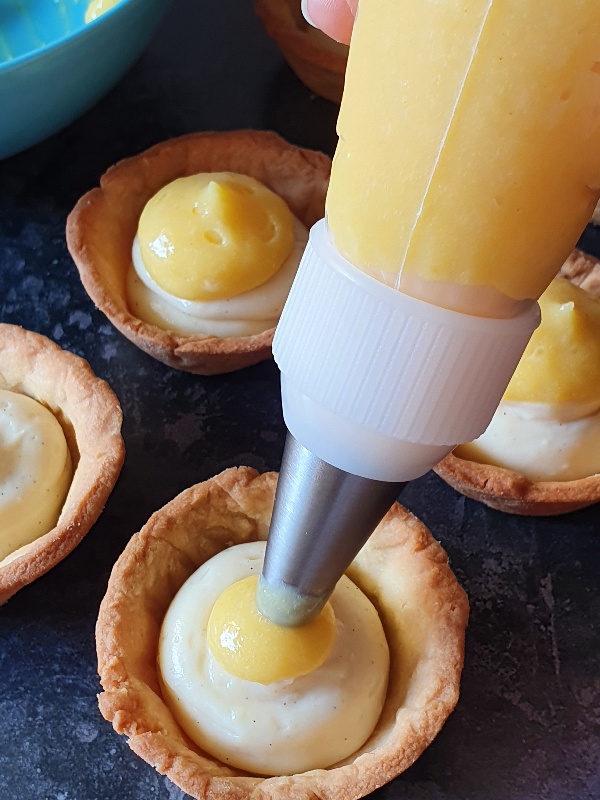Blueberry Lemon Tartlets

It’s About Time
24 March 2022
Chocolate Tea Loaf
12 November 2022
Hello Bakers,
This recipe is my definition of a summer desert made in heaven: melt-in-the-mouth shortcrust pastry cases filled with delicious pastry cream paired up with lemon curd and sweet blueberries. For the ultimately flaky pastry, use cold butter, don’t overwork the dough (be gentle with it, it deserves a bit of TLC) and chill it for a couple of hours. No shortcuts here! Ideally, don’t attempt it on one of the hottest days ever recorded, like I did… Trust me, shortcrust pastry doesn’t co-operate when your kitchen is too warm!
Otherwise, the recipe is pretty straight-forward and no fancy ingredients are necessary. First things first, there a few snippets of knowledge I’d like to share with you before you put your apron on.

Shortcrust pastry
When it comes to shortcrust pastry, the most important thing to remember is temperature, it doesn’t like it to be warm. Use cold butter straight from the fridge and very cold water, also from the fridge. Start by combining the flour and the chopped cold butter together. The aim is a mixture that resembles breadcrumbs. By far the easiest way to achieve that is to use a food processor, but if you don’t have one, go for a good old-fashioned method of rubbing the butter into the flour with your fingertips. Personally, I prefer the latter technique.

I grew up in the eighties and the only electric equipment we had was a hand mixer. Everything else was done by hand and I sort of got used to judging whether the dough is the right consistency by handling it with my hands. (And I still really enjoy the process!)
What does “BB” stand for?
The reason the cold butter is used is to create a protective layer, a sort of “buttery blanket”. (I call it a “Double B” in my baking classes. By no means is it a technical term, I made it up as it’s easier to remember this way.) The cold butter covers the flour particles and stops the gluten from developing too much. If the gluten is too “active”, the pastry ends up too dense, as opposed to light and flaky.

If you use soft butter, the “blanket” won’t hold together and it’ll affect the final texture. You’ll find out in the recipe below that shortcrust pastry is mixed together very quickly and no kneading is required. If you handle the dough for too long the temperature of the butter will change, the dough will become too sticky, and the protective layer won’t work.
Be quick and gentle
Without boring you too much with details, the rule of thumb when making shortcrust pastry is simply to be quick but gentle at the same time. No kneading. Not too much elbow grease. It really is a rub-in-mix-wrap-in-cling-film-chill type of affair.
Lemon curd
I always have a few lemons in my fridge as I use lemon zest in some of my vegan biscuits for my online bake shop. Home-made lemon curd is a fantastic way of using leftover lemons and egg yolks, it’s dead easy. I make it all the time, I mean sometimes every week!

I highly recommend giving it a go (I posted a recipe on Instagram last year, click here) but if it’s not your thing, get a good quality lemon curd in your local supermarket and it’ll work very well too.
Pastry cream
Pastry cream is nothing else but a thicker custard, but sooooo much better! It’s super versatile and used commonly in tarts, pies, eclairs, cakes etc. The most traditional version calls for infusing hot milk with a vanilla pod but since vanilla pods are rather pricey, I use vanilla bean paste instead. It tastes delicious and it’s got lots of tiny, cute vanilla specs which then show beautifully in the cream.
Right, without further ado, ladies and gentleman, I give you my blueberry lemon tartlets.

Blueberry Lemon Tartlets Recipe
Ingredients:
Makes 12 tartlets, 7 cm in diameter, baked in a 12-cup muffin tray
For the shortcrust pastry:
- 200g plain flour
- ¼ teaspoon salt
- 35g icing sugar
- 100g unsalted butter, COLD, chopped
- 2 medium egg yolks
- 1 tablespoon cold water
For the pastry cream:
- 240ml full-fat milk
- 1 teaspoon vanilla bean paste
- 3 medium egg yolks
- 65g caster sugar
- 20g corn flour
- 8g unsalted butter, COLD
For the filling:
- About 270g lemon curd (home-made or shop-bought)
- 150g fresh blueberries
- 12 fresh mint leaves, to decorate (optional)
Also, to blind bake:
- 12 squares (measuring 13cm x 13cm) cut out from baking foil
- Ceramic baking beans or rice
Method
Start off by making the shortcrust pastry. Place the flour, salt and icing sugar in a bowl and mix together. Add the COLD butter and with your fingertips quickly rub it into the dry ingredients until it looks like breadcrumbs. Fold in the egg yolks followed by just one teaspoon of cold water. (You may need to add the remaining teaspoon or two later, if needed.)

With your hands, bring all ingredients together to form a dough. Squeeze it just a few times to make sure it’s homogenous. Remember that when it comes to shortcrust pastry “less is more”, not much kneading is required. Kneading will result in gluten being activated and a tougher, dense texture instead of a light and flaky one. So go easy and be gentle!
At this stage the dough should be soft and pliable. If it doesn’t want to come together and feels a little dry, gradually add more water. (Start just with a few drops; how your dough will behave depends on many factors such as how warm/cold is your kitchen, how warm/cold are your hands, the size of the egg yolks etc.) If the dough is too sticky, add a bit of flour, again start with just a handful or so.

Once the dough is ready, cut it in half, shape each half into a disc, wrap in cling film or greaseproof paper and chill in the fridge for 1-2 hours, until it firms up.
While the dough is chilling, make the pastry cream. Pour the milk into a saucepan, add the vanilla bean paste and on medium heat gradually bring to boil. Careful here – you don’t want the milk to overboil – as soon as you see small bubbles around the edges and some steam forming, take it off the hob.
Place the egg yolks and sugar in a bowl and whisk with a balloon whisk for about a minute or so until runny and pale. Next, whisk in the corn flour and mix until smooth. Now is time to temper the egg yolks to prevent them from cooking when in contact with hot steamy milk. Pour in 3 tablespoons of milk over the egg mixture and whisk vigorously until fully combined. Then, while still whisking, slowly pour in the remaining milk and continue whisking until the mixture is fully incorporated.
Pour it back into the saucepan and heat on medium heat whisking continuously until it thickens up. At the beginning it’ll feel like you’re stirring very frothy milk and nothing is happening, but then suddenly it’ll thicken up very quickly. Take it off the heat right away, tip it the cold butter and mix in until fully melted. Transfer into a bowl, cover the surface of the pastry cream tightly with cling film to prevent a skin from forming. Leave to chill in the fridge for about 2 hours. (Pastry cream can be made up to 24 hours in advance and kept in the fridge.)

Grease the muffin tray. Lightly dust your work surface with some flour and roll out the dough to about 2-3 mm thickness. Stamp out rounds with a 10 cm wide pastry cutter.

To make pastry cases, put the dough disc over the cup and gently ease it into the bottom. Carefully push it in and press around the sides to fit into the cup. Smooth out the folds but don’t worry about them too much; rustic look is the way to go here. Prick the bottom of every pastry case with a fork; it’ll stop air bubbles from forming. Put the muffin tray in the fridge for 15 minutes to chill.

Preheat the oven to 200°C/180°C fan. To blind bake the pastry cases, line each case with a baking foil square making sure it fits in tightly. Cover the bottom with baking beans or rice. Bake for 12-15 minutes.

Take the tray out of the oven, gently remove the baking foil with the baking beans and bake again for 5 minutes until the bottom is dry and the colour is golden brown. Let them cool completely.

Take the chilled cream pastry and if it appears too thick, give it a good stir with a balloon whisk to loosen it up. For the neatest effect transfer to a piping bag and pipe in equal amounts into the 12 pastry cases. If you don’t have a piping bag, use a teaspoon.

Do the same with the lemon curd and pipe in on top of the pastry cream.

Pop the blueberries on top and the mint leaves, if using. Enjoy!



Spread the love if you enjoyed this recipe – give me a like, leave a comment or both. Tag me on Facebook @riseandshinebaking or Instagram @riseandshine_baking and don’t forget to use hashtag #bakewithriseandshine. Thank you.
Download the recipe


